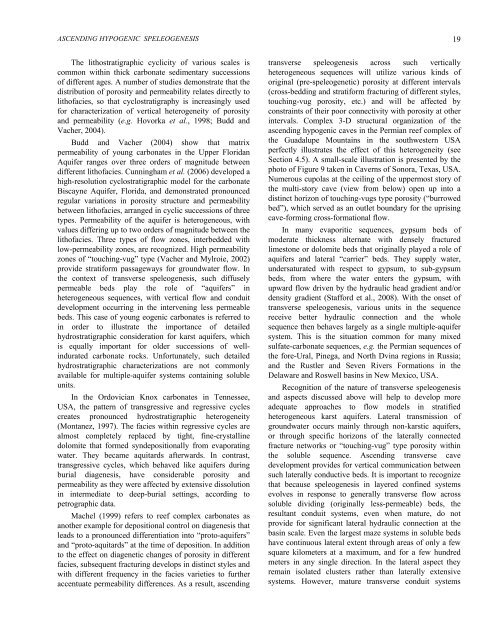Download PDF - Speleogenesis
Download PDF - Speleogenesis
Download PDF - Speleogenesis
Create successful ePaper yourself
Turn your PDF publications into a flip-book with our unique Google optimized e-Paper software.
ASCENDING HYPOGENIC SPELEOGENESIS<br />
The lithostratigraphic cyclicity of various scales is<br />
common within thick carbonate sedimentary successions<br />
of different ages. A number of studies demonstrate that the<br />
distribution of porosity and permeability relates directly to<br />
lithofacies, so that cyclostratigraphy is increasingly used<br />
for characterization of vertical heterogeneity of porosity<br />
and permeability (e.g. Hovorka et al., 1998; Budd and<br />
Vacher, 2004).<br />
Budd and Vacher (2004) show that matrix<br />
permeability of young carbonates in the Upper Floridan<br />
Aquifer ranges over three orders of magnitude between<br />
different lithofacies. Cunningham et al. (2006) developed a<br />
high-resolution cyclostratigraphic model for the carbonate<br />
Biscayne Aquifer, Florida, and demonstrated pronounced<br />
regular variations in porosity structure and permeability<br />
between lithofacies, arranged in cyclic successions of three<br />
types. Permeability of the aquifer is heterogeneous, with<br />
values differing up to two orders of magnitude between the<br />
lithofacies. Three types of flow zones, interbedded with<br />
low-permeability zones, are recognized. High permeability<br />
zones of “touching-vug” type (Vacher and Mylroie, 2002)<br />
provide stratiform passageways for groundwater flow. In<br />
the context of transverse speleogenesis, such diffusely<br />
permeable beds play the role of “aquifers” in<br />
heterogeneous sequences, with vertical flow and conduit<br />
development occurring in the intervening less permeable<br />
beds. This case of young eogenic carbonates is referred to<br />
in order to illustrate the importance of detailed<br />
hydrostratigraphic consideration for karst aquifers, which<br />
is equally important for older successions of wellindurated<br />
carbonate rocks. Unfortunately, such detailed<br />
hydrostratigraphic characterizations are not commonly<br />
available for multiple-aquifer systems containing soluble<br />
units.<br />
In the Ordovician Knox carbonates in Tennessee,<br />
USA, the pattern of transgressive and regressive cycles<br />
creates pronounced hydrostratigraphic heterogeneity<br />
(Montanez, 1997). The facies within regressive cycles are<br />
almost completely replaced by tight, fine-crystalline<br />
dolomite that formed syndepositionally from evaporating<br />
water. They became aquitards afterwards. In contrast,<br />
transgressive cycles, which behaved like aquifers during<br />
burial diagenesis, have considerable porosity and<br />
permeability as they were affected by extensive dissolution<br />
in intermediate to deep-burial settings, according to<br />
petrographic data.<br />
Machel (1999) refers to reef complex carbonates as<br />
another example for depositional control on diagenesis that<br />
leads to a pronounced differentiation into “proto-aquifers”<br />
and “proto-aquitards” at the time of deposition. In addition<br />
to the effect on diagenetic changes of porosity in different<br />
facies, subsequent fracturing develops in distinct styles and<br />
with different frequency in the facies varieties to further<br />
accentuate permeability differences. As a result, ascending<br />
transverse speleogenesis across such vertically<br />
heterogeneous sequences will utilize various kinds of<br />
original (pre-speleogenetic) porosity at different intervals<br />
(cross-bedding and stratiform fracturing of different styles,<br />
touching-vug porosity, etc.) and will be affected by<br />
constraints of their poor connectivity with porosity at other<br />
intervals. Complex 3-D structural organization of the<br />
ascending hypogenic caves in the Permian reef complex of<br />
the Guadalupe Mountains in the southwestern USA<br />
perfectly illustrates the effect of this heterogeneity (see<br />
Section 4.5). A small-scale illustration is presented by the<br />
photo of Figure 9 taken in Caverns of Sonora, Texas, USA.<br />
Numerous cupolas at the ceiling of the uppermost story of<br />
the multi-story cave (view from below) open up into a<br />
distinct horizon of touching-vugs type porosity (“burrowed<br />
bed”), which served as an outlet boundary for the uprising<br />
cave-forming cross-formational flow.<br />
In many evaporitic sequences, gypsum beds of<br />
moderate thickness alternate with densely fractured<br />
limestone or dolomite beds that originally played a role of<br />
aquifers and lateral “carrier” beds. They supply water,<br />
undersaturated with respect to gypsum, to sub-gypsum<br />
beds, from where the water enters the gypsum, with<br />
upward flow driven by the hydraulic head gradient and/or<br />
density gradient (Stafford et al., 2008). With the onset of<br />
transverse speleogenesis, various units in the sequence<br />
receive better hydraulic connection and the whole<br />
sequence then behaves largely as a single multiple-aquifer<br />
system. This is the situation common for many mixed<br />
sulfate-carbonate sequences, e.g. the Permian sequences of<br />
the fore-Ural, Pinega, and North Dvina regions in Russia;<br />
and the Rustler and Seven Rivers Formations in the<br />
Delaware and Roswell basins in New Mexico, USA.<br />
Recognition of the nature of transverse speleogenesis<br />
and aspects discussed above will help to develop more<br />
adequate approaches to flow models in stratified<br />
heterogeneous karst aquifers. Lateral transmission of<br />
groundwater occurs mainly through non-karstic aquifers,<br />
or through specific horizons of the laterally connected<br />
fracture networks or “touching-vug” type porosity within<br />
the soluble sequence. Ascending transverse cave<br />
development provides for vertical communication between<br />
such laterally conductive beds. It is important to recognize<br />
that because speleogenesis in layered confined systems<br />
evolves in response to generally transverse flow across<br />
soluble dividing (originally less-permeable) beds, the<br />
resultant conduit systems, even when mature, do not<br />
provide for significant lateral hydraulic connection at the<br />
basin scale. Even the largest maze systems in soluble beds<br />
have continuous lateral extent through areas of only a few<br />
square kilometers at a maximum, and for a few hundred<br />
meters in any single direction. In the lateral aspect they<br />
remain isolated clusters rather than laterally extensive<br />
systems. However, mature transverse conduit systems<br />
19
















